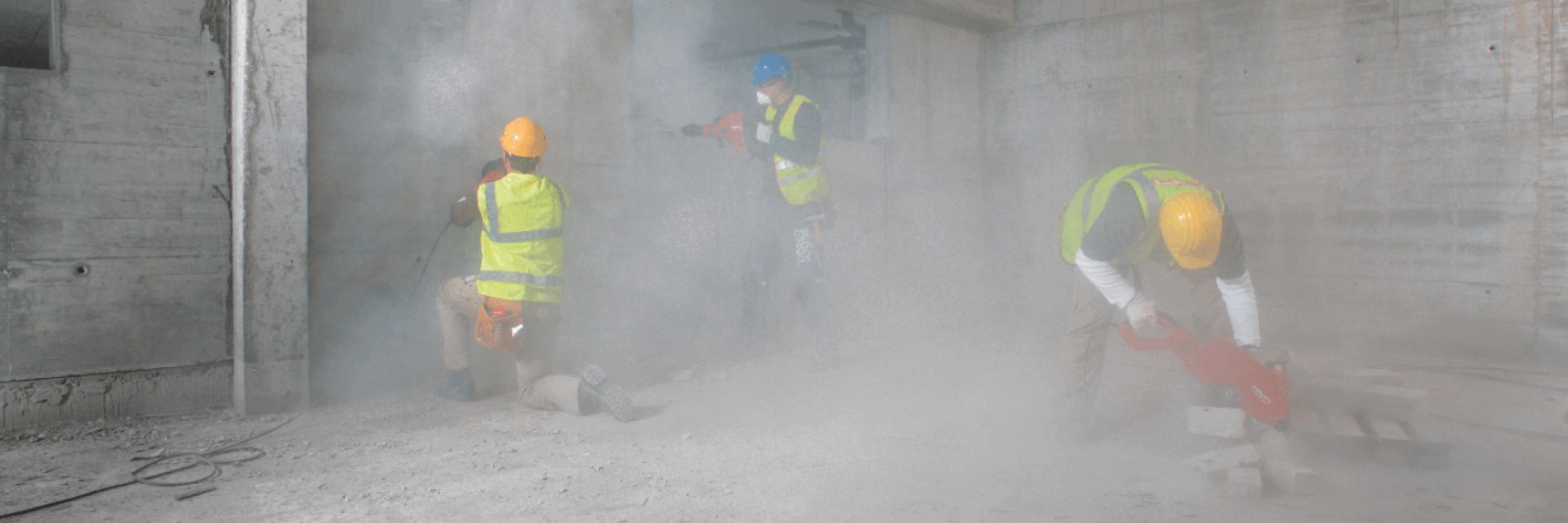- Home
- Company
- Media Relations
- Industry Blog
- Dust control
- The hazards of crystalline silica dust and why you should control it
The hazards of crystalline silica dust and why you should control it
There are many hazards on a construction site, but few are as silent, invisible or disabling as inhalable crystalline silica dust. So what exactly is crystalline silica dust and most importantly, how can its effects be prevented?

What is silica dust?
Silica dust is a naturally occurring mineral compound and is the second most common mineral in the earth's crust. It is found in a number of the most common building materials including:
- Concrete
- Sand
- Clay
- Bricks
- Stone
- Rock
The dust itself is created usually upon drilling, cutting or grinding the above materials. When disturbed crystalline silica can form tiny dust particles which can be breathed into the lungs. This is known as repairable crystalline silica (RCS) and is the most dangerous form of silica dust. In some cases RCS can be so small that it cannot be seen by the naked eye.
The nature of silica dust means that it presents risk to a number of occupation in a variety of industries, including:
- Quarrying
- Mining
- Construction
- Concrete manufacture
- Brick and tile manufacture
What are the hazards caused by silica dust?
Exposure to silica dust, particularly in its breathable form as RCS, can cause severe chronic health problems. The following diseases are known to be caused by breathing in silica dust:
- Silicosis: Inhaling silica dust into the lungs can cause scarring. This is a chronic condition with a variety of symptoms that will be explained further below.
- Chronic obstructive pulmonary disease (COPD): A chronic lung condition that can lead to breathing difficulties, wheezing or chronic cough.
- Kidney disease: There is some evidence that kidney disease can be a side effect of exposure to silica dust.
- Lung cancer: Lengthy exposure to silica dust is known in some cases to lead to lung cancer.
Silicosis
Silicosis is the most common health complaint from those who are exposed to silica dust. Known in the past as miners phthisis or grinder's asthma, it is considered an occupational lung disease marked by inflammation and scarring of lung tissue. When crystalline silica dust is breathed in dust particles become embedded in the lung wall. The lung tissue reacts by developing fibrotic nodules and scarring around the trapped particles. Over time this scar tissue hardens the lungs, making it very difficult and often painful to breathe.
There are three main forms of silicosis:
Chronic silicosis
The most common form of the disease, chronic silicosis often goes undetected for many years. Abnormalities may be detected up to 15-20 years after exposure. As with all forms of silicosis the progression of the disease can be stopped, but it cannot be cured completely.
Acute silicosis
After exposure to extreme amount of RCS acute silicosis can become apparent rapidly. In this case, symptoms are often disabling and develop very quickly. They can lead to death.
Accelerated silicosis
This often develops five to 10 years after high exposure to RCS. Symptoms are similar to chronic silicosis but appear faster and accelerate quickly.
What are the main symptoms of silicosis?
Silicosis can sometimes lie undetected for many years. When symptoms do begin to present themselves they may include:
- Shortness of breath
- Persistent cough
- Weight loss and reduced appetite
- Chest pain
- Fever
- Bluish tint to skin
Methods to limit/remove exposure to silica dust
The severity of the health impacts caused by exposure to silica dust means that great care should be taken to minimise both the presence of silica dust and workers exposure to it. The following are some key approaches to manage silica dust.
Dust control methods
There are many dust removal systems which aim to either keep dust out of the air where it is most dangerous or remove it at source before it can be breathed in. the two main version include:
- Wet working: Where a constant flow of water is used to absorb dust particles before they become airborne. For example, wet coring large holes for anchors or rebar instead of hammer drilling them. Systems such as Hilti's DD-WMS 100 water management system, make this efficient and safe.
- Dust removal systems: Dust control and collection systems fitted to machinery can greatly reduce the danger of RCS. This includes items like dust hoods connected to vacuum cleaners or hollow drill bits that remove dust as you drill.
Managing your site
Clear management of the site where dust is created can ensure the safety not just of those working there but also those who may be passing or living nearby.
- Exclusions zones: Marking boundaries of work areas where RCS is created and will be a high risk can help to limit the number or workers exposed.
- Exposure breaks: Work out which activities have a risk of high RCS exposure and schedule in breaks in these activities to limit the risk to individual workers.
Personal protective equipment
Where work has to be undertaken which has a risk of RCS inhalation, protective clothing can be worn. This includes:
- Respirators: Carefully chosen respirators designed to eliminate dust inhalation can protect against RCS. These should be regularly tested and workers wearing them should be trained on correct wearing and storage.
- Protective clothing: Overalls, gloves and goggles can prevent dust being carried home.
For more information on silica dust and prevention methods get in touch with your local account manager, click here.
